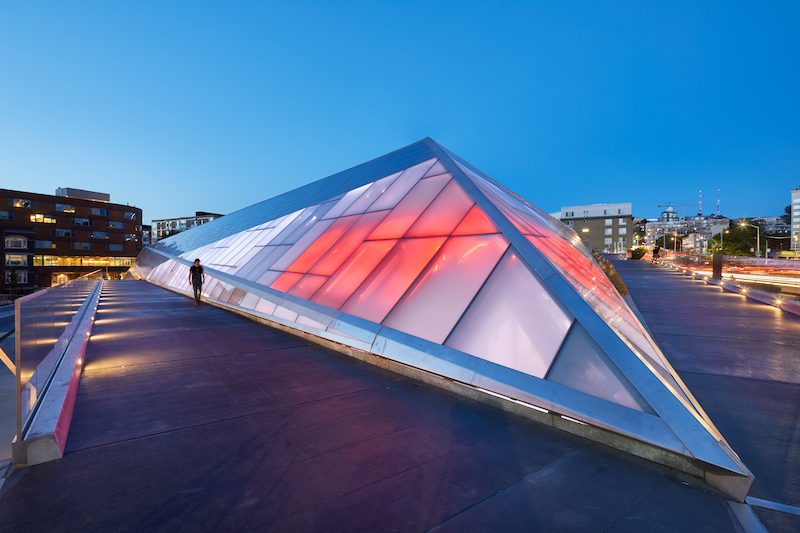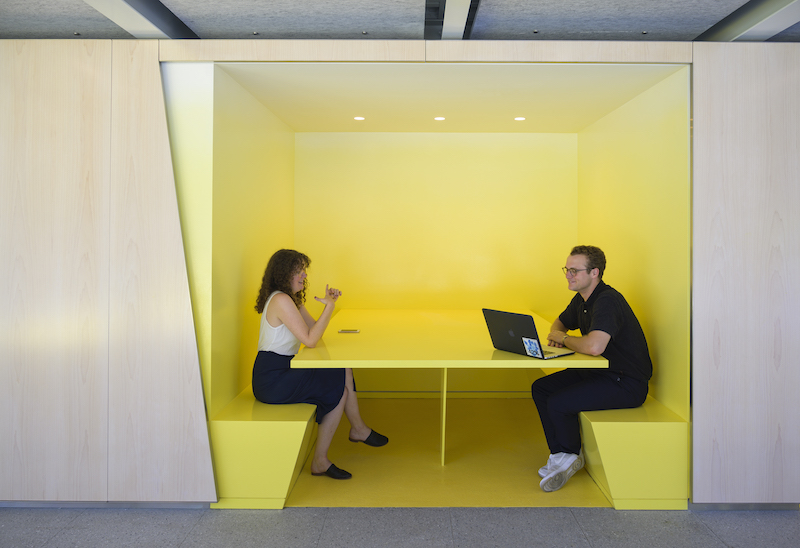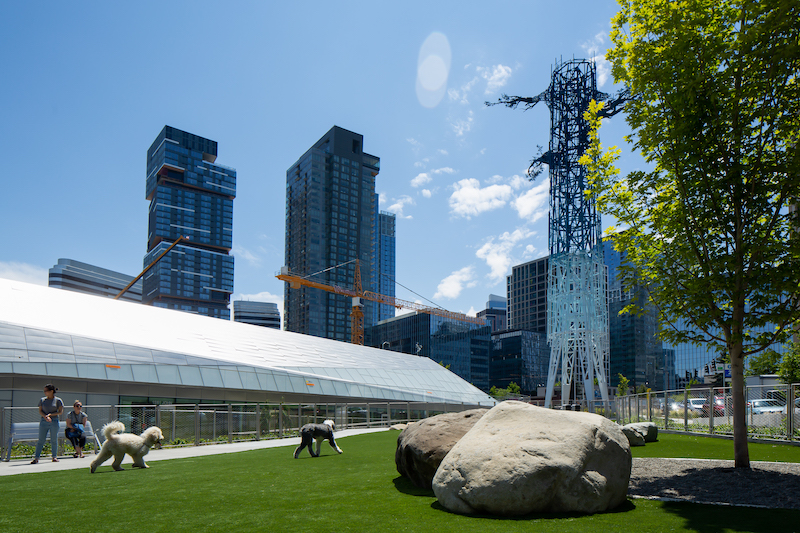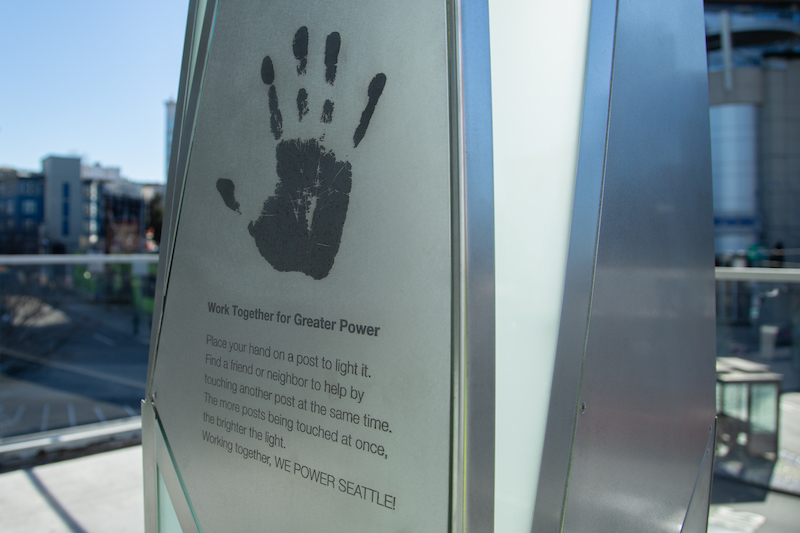Last month, the first substation built in Seattle in three decades opened between that city’s fast-growing South Lake Union area and Denny Triangle.
The Denny Substation officially debuted on July 20. It is the culmination of a three-year construction and multiyear planning and community engagement process between the facility’s designer, NBBJ, and Seattle City Lights, the city-owned electric utility.
The $210 million substation complex—which ran $100 million over its initial cost projections in 2005 due to rising construction costs and increases in the neighborhood's power needs in the ensuing years—covers more than 120,000 sf within a block and a half of real estate where a former Greyhound bus maintenance terminal once stood. The complex includes the 10,000-sf substation with slanted, stainless-steel walls that pick up color from sunlight and the sky. Translucent glass panels emit a soft glow when illuminated at night. Ambient light is strategically placed to brighten the building’s interior space.
 Panels allow visitors to see into the facility, and highlights the centrality of energy in the neighborhood's vitality. Image: Benjamin Benschneider
Panels allow visitors to see into the facility, and highlights the centrality of energy in the neighborhood's vitality. Image: Benjamin Benschneider
Translucent and transparent walls, 35 feet high, allow visitors to view directly into the substation. This feature is meant to remind the public about the production and importance of energy and power in daily life. Indeed, what makes this project unique is how it has been designed to be friendly to users and the community at large.
ALSO SEE: Energizing the Neighborhood
There’s an ADA-compliant elevated diagonal walkway, one-quarter mile long, that wraps around the building. The west side of the site includes a 44,000-sf public green with an off-leash dog park and space for food trucks.
 Part of the Community Meeting Space inside the Denny Substation. Image: Ryne Hill and NBBJ
Part of the Community Meeting Space inside the Denny Substation. Image: Ryne Hill and NBBJ
Inside the substation are a 3,900-sf Community Meeting Space, and a 2,900-sf Energy Inspiration Space, with a pantry, offices, immersive theater, activity zone, and exhibition space. The substation has its own public art program that incorporates permanent artworks, temporary pieces, and ongoing cultural and artistic programming.
The Denny Substation, powered mostly by hydroelectric energy, is projected to be Net Positive, generating 105% of the energy needs and projected to achieve an Energy Use Intensity level of 15.5, on par with Seattle’s Bullitt Center, one of the country’s greenest office buildings. The substation is targeting Petal Certification from the Living Building Challenge.
 An off-leash dog park is part of the public space within the substation's premises. Image: NBBJ
An off-leash dog park is part of the public space within the substation's premises. Image: NBBJ
 An interactive kiosk allows visitors to illuminate a post, thereby emphasizing the interaction between residents and power sources. Image: NBBJ
An interactive kiosk allows visitors to illuminate a post, thereby emphasizing the interaction between residents and power sources. Image: NBBJ
Related Stories
| Sep 24, 2014
Architecture billings see continued strength, led by institutional sector
On the heels of recording its strongest pace of growth since 2007, there continues to be an increasing level of demand for design services signaled in the latest Architecture Billings Index.
| Sep 24, 2014
Frank Gehry's first building in Latin America will host grand opening on Oct. 2
Gehry's design for the Biomuseo, or Museum of Biodiversity, draws inspiration from the site's natural and cultural surroundings, including local Panamaian tin roofs.
| Sep 23, 2014
Third phase of New York’s High Line redevelopment opens
The $35 million Phase 3, known as High Line at the Rail Yards, broke ground September 20, 2012, and officially opened to the public on September 21.
| Sep 23, 2014
Cloud-shaped skyscraper complex wins Shenzhen Bay Super City design competition
Forget the cubist, clinical, glass and concrete jungle of today's financial districts. Shenzhen's new plan features a complex of cloud-shaped skyscrapers connected to one another with sloping bridges.
| Sep 22, 2014
4 keys to effective post-occupancy evaluations
Perkins+Will's Janice Barnes covers the four steps that designers should take to create POEs that provide design direction and measure design effectiveness.
| Sep 22, 2014
Sound selections: 12 great choices for ceilings and acoustical walls
From metal mesh panels to concealed-suspension ceilings, here's our roundup of the latest acoustical ceiling and wall products.
| Sep 18, 2014
Final designs unveiled for DC's first elevated park
OMA, Höweler + Yoon, NEXT Architects, and Cooper, Robertson & Partners have just released their preliminary design proposals for what will be known as the 11th Street Bridge Park.
| Sep 16, 2014
Competition asks architects, designers to reimagine the future of national parks
National Parks Now asks entrants to propose all types of interventions for parks, including interactive installations, site-specific education and leisure opportunities, outreach and engagement campaigns, and self-led tours.
| Sep 11, 2014
5 competing designs unveiled for Presidio Parklands in San Francisco
To turn the underdeveloped area by Chrissy Field into new public space, San Francisco's Presidio Trust unveiled the five designs by five teams they invited earlier this year.
| Sep 9, 2014
Using Facebook to transform workplace design
As part of our ongoing studies of how building design influences human behavior in today’s social media-driven world, HOK’s workplace strategists had an idea: Leverage the power of social media to collect data about how people feel about their workplaces and the type of spaces they need to succeed.
















